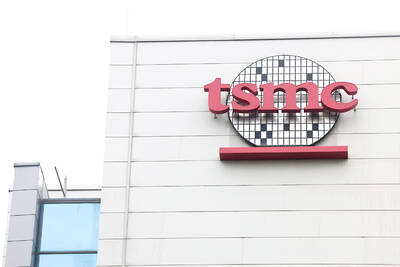Assembly lines around the world are starting to hum again, marking a turn in a years-long manufacturing slump.
The nascent industrial recovery is led by the world’s two biggest economies. Chinese manufacturing has made a strong start to the year, boosting the economic outlook, and US factory activity unexpectedly expanded last month for the first time since September 2022, buoyed by rising new orders and a jump in production.
JPMorgan Chase & Co and S&P Global Inc’s manufacturing index notched a second month above expansionary territory last month and sits at the highest level since July 2022. If sustained, that would help catalyze a broader and stronger economic recovery that is already spreading beyond the US.

Photo: Bloomberg
“Manufacturing PMIs [purchasing managers’ indices] are back to expansion in key economies including China, the UK and the US,” said Janet Mui, head of market analysis at RBC Brewin Dolphin. “The synchronized nature of the recovery tends to be a good signal for a cyclical upturn in global growth.”
While it is still early days — a surprise downturn in China’s exports suggests the recovery might be bumpy — the activity nonetheless marks a departure from the slowdown that took hold globally as consumer demand pivoted to spending more on services such as travel and dining out instead of buying more goods as COVID-19-pandemic-era restrictions ended.
Adding to the optimism is German industrial production that started the year on a two-month roll, underpinning hopes that Europe’s biggest economy might emerge from a recession. Asian export powerhouses including South Korea and Japan are also showing improvement.
The Asian Development Bank expects that a turnaround in merchandise exports starting around midyear would drive growth in Thailand, Vietnam, the Philippines and Malaysia. Leading the way for South Asia this year and next would be India, which wants to rival China as the world’s factory floor.
That manufacturing strength would ensure the world skirts a recession and grows closer to its potential, Moody’s Analytics chief economist Mark Zandi said.
“Global manufacturing activity appears to be slowly reviving,” Zandi said. “I don’t expect global manufacturing to come roaring back given continued high global interest rates, higher oil prices and supply-chain disruptions, but I do expect continued improvement.”
Such uncertainty is why the WTO last week predicted that the volume of global merchandise trade would rebound only modestly this year from a rare contraction last year.
Total goods trade would increase 2.6 percent this year, the WTO said, a downgrade from its 3.3 percent growth projection in October last year and in line with the average pace since 2010.
“The lingering effects of high energy prices and inflation weighed especially heavily on demand for trade-intensive manufactured goods” last year, the WTO said in the report. “But this should recover gradually over the next two years as inflationary pressures ease and as real household incomes improve.”
Still, any talk of a cyclical upturn needs to be distinguished from longer-term realignments.
ING Groep NV economists called the latest report in Germany showing higher industrial production a “balm for the German economic soul.”
However, they also warned that there is still a way to go before declaring an end to the downturn.
German factories are operating 8 percent below their pre-pandemic levels and industries are still undergoing structural shifts in trade tied to geopolitical tensions.
In the UK, a report on Friday showed that manufacturing rose 1.2 percent last month, a much stronger than expected showing, following last month’s reading on factory purchasing managers that was the best since July 2022.
Southern European economies are punching above their weight as growth drivers in the euro area. Business surveys by S&P Global released earlier this month showed that Spain and Italy beat economists’ expectations with faster expansion last month.
In the US, the consumption engine for foreign goods appears to be revving up again after companies let inventories run off last year and supply chains that got knotted up during COVID-19 look normal again.
The volume of US container imports reached 6.56 million during the first quarter, up 16 percent from a year earlier and well above pre-pandemic levels in 2018 and 2019, according to Descartes Datamyne.
James Knightley, chief international economist at ING Group, described the improving outlook as more stabilization than rebound and the headwinds would not be unwinding anytime soon — but it is a turn nonetheless.
“I would say there is some cautious optimism that the worst is over,” he said.

When an apartment comes up for rent in Germany’s big cities, hundreds of prospective tenants often queue down the street to view it, but the acute shortage of affordable housing is getting scant attention ahead of today’s snap general election. “Housing is one of the main problems for people, but nobody talks about it, nobody takes it seriously,” said Andreas Ibel, president of Build Europe, an association representing housing developers. Migration and the sluggish economy top the list of voters’ concerns, but analysts say housing policy fails to break through as returns on investment take time to register, making the

NOT TO WORRY: Some people are concerned funds might continue moving out of the country, but the central bank said financial account outflows are not unusual in Taiwan Taiwan’s outbound investments hit a new high last year due to investments made by contract chipmaker Taiwan Semiconductor Manufacturing Co (TSMC, 台積電) and other major manufacturers to boost global expansion, the central bank said on Thursday. The net increase in outbound investments last year reached a record US$21.05 billion, while the net increase in outbound investments by Taiwanese residents reached a record US$31.98 billion, central bank data showed. Chen Fei-wen (陳斐紋), deputy director of the central bank’s Department of Economic Research, said the increase was largely due to TSMC’s efforts to expand production in the US and Japan. Investments by Vanguard International

STRUGGLING TO SURVIVE: The group is proposing a consortium of investors, with Tesla as the largest backer, and possibly a minority investment by Hon Hai Precision Nissan Motor Co shares jumped after the Financial Times reported that a high-level Japanese group has drawn up plans to seek investment from Elon Musk’s Tesla Inc to aid the struggling automaker. The group believes the electric vehicle (EV) maker is interested in acquiring Nissan’s plants in the US, the newspaper reported, citing people it did not identify. The proposal envisions a consortium of investors, with Tesla as the largest backer, but also includes the possibility of a minority investment by Hon Hai Precision Industry Co (鴻海精密) to prevent a full takeover by the Apple supplier, the report said. The group is

EARLY TALKS: Measures under consideration include convincing allies to match US curbs, further restricting exports of AI chips or GPUs, and blocking Chinese investments US President Donald Trump’s administration is sketching out tougher versions of US semiconductor curbs and pressuring key allies to escalate their restrictions on China’s chip industry, an early indication the new US president plans to expand efforts that began under former US president Joe Biden to limit Beijing’s technological prowess. Trump officials recently met with their Japanese and Dutch counterparts about restricting Tokyo Electron Ltd and ASML Holding NV engineers from maintaining semiconductor gear in China, people familiar with the matter said. The aim, which was also a priority for Biden, is to see key allies match China curbs the US